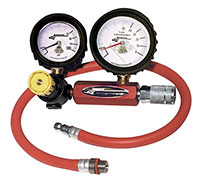Should I get a compression tester or a leak-down tester? This is a common question, particularly from racers who are considering rebuilding their own engines for the first time (and usually followed up with a comment about the higher cost of a leak-down tester). But after a compression test is done, we often hear another question: Are my results good or bad? Is it time to rebuild the engine or not? This article aims to outline the advantages and disadvantages of each type of test. As you will see, there is no one-size-fits-all answer. |
What do they do?
Both tools are designed to measure cylinder pressure in order to highlight and diagnose engine problems. A compression tester is a stand-alone tool that relies on the engine's compression to build pressure in the cylinder. A leak-down tester relies on an external supply of compressed air.
If you stopped reading right now, a novice might choose a compression tester. You can't use a leak-down tester without an air compressor or nitrogen tank. Someone just getting into engine work might not have either of those in the shop, which could mean a considerable extra investment.
How do they do it?
To use a compression tester, you remove the spark plugs, insert the hose of the tester into one spark plug hole, and crank the engine over. After about 4 to 8 revolutions, you read the pressure on the gauge. Repeat the test for each cylinder of the engine.
To use a leak-down tester, you remove the spark plugs as above and rotate the engine until the piston is at top dead center for the cylinder you are testing. Insert the leak-down tester hose into the spark plug hole, then connect it to a compressed air source of at least 100 psi. Most leak-down testers have a regulator to adjust the air pressure down to exactly 100 psi. Now you read the second gauge on the leak-down tester, which indicates the amount of pressure actually in the cylinder. Subtract this reading from 100 to determine the percentage of leak-down. (Note that some testers, including our Longacre Dual Gauge Leak-Down Tester, actually show the amount of leakage on the second gauge, eliminating the math.)
What's the difference?
Since the compression tester relies on the engine cranking, several uncontrolled variables are introduced which can make the results less useful. A weak battery, a corroded starter cable, or a hot starter can all cause the engine to crank slower, which can affect the test results. Even air density and valve lash can affect the readings. For this reason, it's next to impossible to find suggested compression test results for most engines. On top of that, racing engines are usually modified to have higher compression anyway, so you can't rely on a factory manual for the answer. (But don't give up on the compression tester just yet, read on!)
The use of a controlled, regulated compressed air source makes a leak-down test much more consistent and repeatable. This means that a leak-down tester can be used to show when an engine is in need of a rebuild due to wear. If the percentage of leakage in an engine goes up from one test to the next (especially if all cylinders increase a similar amount), you can be reasonably confident that it is due to a loss of cylinder sealing. Depending on your budget and how much power you are willing to give up, you will probably want to rebuild the engine when leak-down reaches somewhere around 10% to 15%. Fresh engines should not leak more than about 3%. Many engine builders consider 5% to still be quite healthy.
So is a compression tester worthless?
No! A compression tester has a place in any racer's toolbox. It is still a useful tool, especially at the track where a compressed air source isn't available.
A compression tester is a quick and easy way to show if a catastrophic problem exists, and on which cylinder(s). If your engine drops a cylinder or two, a quick compression test will determine if something is physically wrong inside the engine. If there is, the affected cylinder(s) will show compression numbers significantly lower than the others. The only remaining question is why. Is it a bent valve? Broken piston ring? Blown head gasket? You may not know the answer just from using a compression tester, but you will know one answer: Whether or not you need to open up the engine for a closer look.
But wait, there's more!
A leak-down tester can actually point you towards the source of the problem. Just listen for the escaping air.
| Leak-Down Testing Quick Symptom Guide | |
|---|---|
| Test Result | Common Causes |
| Whistling, humming, or pressure in exhaust | · Burned exhaust valve · Bent exhaust valve |
| Whistling through intake | · Bent intake valve |
| Whistling through both intake and exhaust |
· Multiple bent valves · Shifted valve seats |
| Whistling from dry sump tank or crankcase breather |
· Broken piston ring · Burned piston |
| Bubbling in coolant | · Blown head gasket |
Based on these results, you can decide if it's worth opening up the engine at the track. You can probably change a head gasket during the lunch break, but a burned piston or a broken ring might make you call it a day.
A few more random thoughts
You might think of a compression test like a doctor taking your pulse, and a leak-down test like a full EKG stress test. Your pulse can show an indication of a problem (if you have no pulse, you probably need a rebuild), but "normal" can vary depending on the individual and the circumstances. An EKG can be used for a more accurate measurement of how well your heart works. Or maybe a compression test is more like a "check engine" light - it can tell you if there's a problem, but you need a scan tool to find where the problem is.
One test result where a compression tester can be as good as a leak-down test: If two cylinders side-by-side have lower compression than the rest, the most likely cause is a blown head gasket between the cylinders. In this case, pressure is escaping from one cylinder to the other.
You can perform a leak-down test with the piston at bottom dead center. If air escapes into the crankcase during this test but not with the piston at TDC, you're likely looking at a cracked or badly scored cylinder wall.
What have we learned?
Although a compression tester alone won't give you a detailed picture of your engine's health, it can (and should) be used first if there is any reason to believe that a problem might exist.
A leak-down tester may represent a larger initial investment, and a leak-down test takes more time to perform, but it can give you a more accurate and detailed picture of the engine's overall health.

